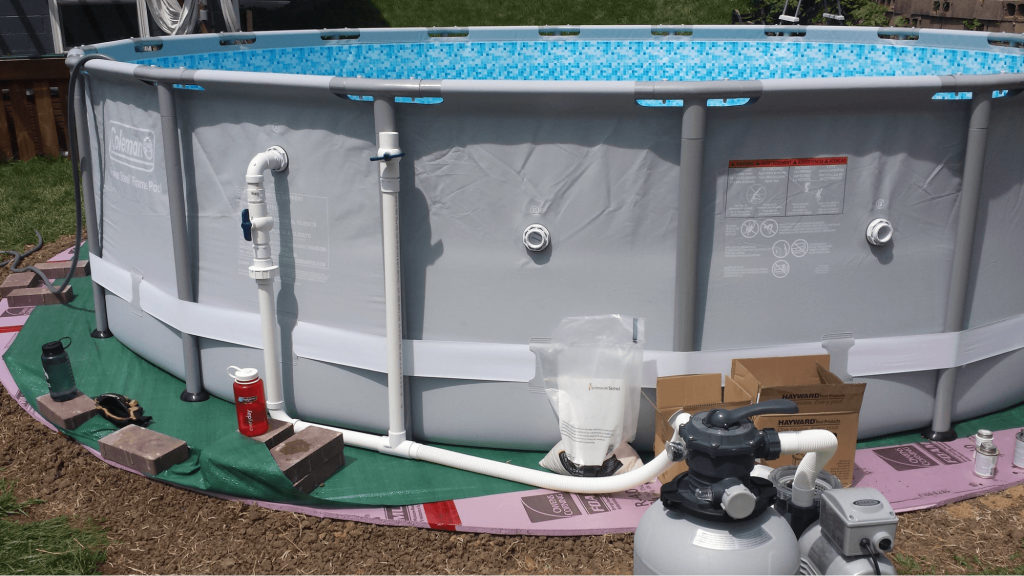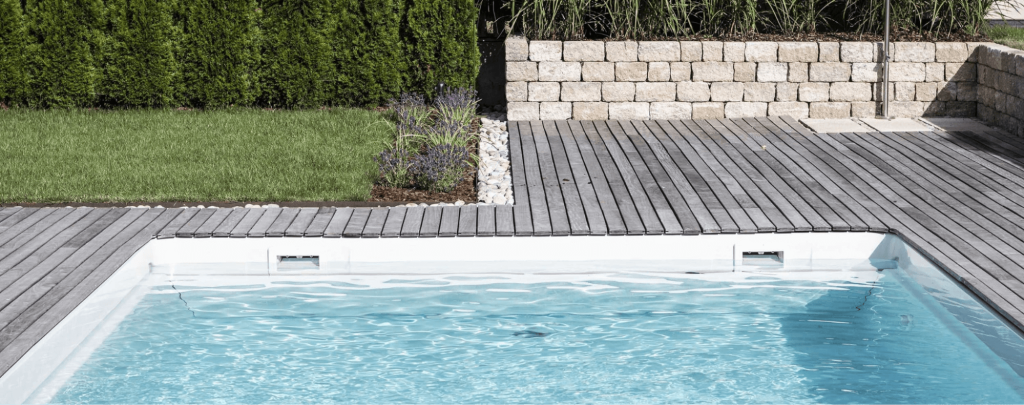The skimmer is an essential part of every pool. Over time, however, even the most reliable skimmers can wear out or become less effective. Leaks, corrosion, and poor performance are all signs that your pool skimmer needs to be replaced.
We conducted extensive research to find all the tips and hints to make everything go effortlessly. We’ll discuss everything about what are the symptoms of the pool skimmer replacement, how to prevent such issues in the future, and how to replace it with a breeze.
Whether you’re a curious pool owner or a newcomer to pool maintenance, keep scrolling to discover how fixing skimmer issues will help you keep your pool crystal clear and shining.
Understanding Skimmer: What It Is and How It Works
The skimmer is a vital component of your pool’s filtration system. It’s often referred to as the first line of defense against debris and contaminants. Its primary goal is to catch as much of the water’s surface as possible to free it from leaves, insects, oils, and other unwanted pollutants before it can sink to the bottom.
When your pool’s pump is running, it creates a flow of water that pulls water from the surface into the skimmer. The skimmer basket collects larger debris, while the finer particles and contaminants are captured by the pool’s filtration system. This continuous circulation process helps maintain water clarity.
This not only keeps your pool looking clean and attractive but also plays a significant role in maintaining proper water balance and chemical stability.

Types of Pool Skimmers and Their Difference
Pool skimmers come in various designs and sizes: each created for specific pool types and needs. Understanding the different types of pool skimmers and their unique features is crucial when considering a replacement. Let’s dive into the common types and explore their differences.

Skimmers for in-ground pools
| These skimmers are typically installed along the pool’s edge and are connected to the pool’s plumbing system. In-ground skimmers often have multiple suction ports and provide efficient surface cleaning for larger pools. |
| Compatibility | Debris load | Installation | Maintenance |
| In-ground pools | Tiny, mild debris | Usually requires professional installation | You need to empty your basket at least once per 1–2 weeks |

Skimmers for above-ground pools
Above-ground skimmers are easy to install and usually come with a built-in vacuum plate. They attach to the pool wall and utilize the pool’s pump and filtration system to clean the surface.
| Compatibility | Debris load | Installation | Maintenance |
| Above-ground pools | Tiny, mild debris | Effortless, DIY-friendly | Frequent basket cleaning is required |

Wide-mouth skimmers
Wide-mouth skimmers have a larger opening and basket capacity, making them ideal for areas with heavy debris, such as falling leaves. They help minimize the frequency of emptying the skimmer basket.
| Compatibility | Debris load | Installation | Maintenance |
| All pool types | Any kind of debris | DIY-friendly, professional help may be needed | Moderate to frequent basket cleaning is required |
Why Would You Need to Replace a Skimmer?
Over time, even the highest-quality skimmers will face wear and tear, leading to the need for replacement. Let’s explore the reasons why you might need to replace a pool skimmer and the most popular signs that indicate it’s time to take action.
- Wear and Deterioration
This is a common consequence of your pool skimmer being constantly exposed to water, chemicals, and different weather conditions. Over time, the materials may degrade, which leads to cracks, leaks, or weakened structural integrity. If you notice visible signs of damage, such as cracks or crumbling surfaces, it’s a clear sign that a replacement is necessary.
- Corrosion and Rust
Pool chemicals can provoke corrosion and rust on the metal components of the skimmer. Corrosion not only affects the skimmer’s appearance but also compromises its performance and durability.
- Leaks and Water Loss
A damaged or deteriorated skimmer can develop leaks, leading to water loss and potentially affecting your pool’s water level.
- Ineffective Debris Removal
The primary function of a skimmer is to remove debris from the pool’s surface. If your skimmer is struggling to capture leaves, bugs, or other debris, it might be due to reduced suction caused by clogs or a malfunctioning mechanism. In such cases, replacing the skimmer can restore efficient debris removal.

Full Guide on Pool Skimmer Replacement
Replacing a pool skimmer requires careful preparation and the right tools and materials to ensure a successful and efficient process. We prepared the table with essential items you’ll need for a pool skimmer replacement.
| Tools | Materials | Optional |
Screwdrivers* Adjustable wrench Pipe cutter Teflon tape Bucket with a sponge Level Utility knife Pliers Caulk gun | New skimmer kit PVC pipes and fittings Replacement hardware Backfill material Sealant Pool putty Threaded connectors Pool liner patch kit | |
| Safety gear | Gloves and safety goggles protect your hands and eyes during the process. | |
*- italics stay for tools that are necessary for above-ground pool skimmer replacement.
Safety Measures to Make Everything Smoothly
You won’t be able to enjoy the results of your pool skimmer replacement if you’d damage yourself. So let’s explore the necessary steps to make the process go as safely and painlessly as possible.
Foremost, we recommend that you turn off your pool equipment before starting. In addition, turn off your water supply to prevent any harmful experience. Then, prepare the area – remove everything that may interfere with your focus. Keep all your tools in a safe and convenient-for-use position. And of course, don’t forget to wear your protective gear.
Step-By-Step Above-Ground Pool Skimmer Replacement
Replacing an above-ground pool skimmer might seem like a complex task. But with our instructions, you can turn your pool skimmer replacement into a manageable DIY project.
How to Remove an Old Skimmer
Start by lowering the water level below your skimmer. Then remove the skimmer lid and basket. Carefully disconnect the pipes and fittings connected to the old skimmer. Once done, unscrew all the bolts securing the skimmer faceplate to the pool wall to easily detach the old skimmer from the pool wall.
New Skimmer Installation
The first step, to begin with, is to place the new skimmer faceplate against the pool wall, aligning it with the existing holes. Then, insert the skimmer gasket between the faceplate and the pool wall to ensure a watertight seal. Secure the faceplate using screws or bolts provided with the new skimmer.

Instructions on How to Replace an In-Ground Pool Skimmer
Before you begin your pool skimmer replacement, double-check you have all the necessary materials and tools on hand. You’ll need a new skimmer that matches the specifications of your pool, sealant, PVC pipes, a pipe cutter, a wrench, a screwdriver, a utility knife, and a pool skimmer gasket.
How to Remove Old Skimmer
To remove the old skimmer, you’ll need to lower the water level in your pool to below the opening. Use a submersible pump or a hose to siphon out the water until it’s below the skimmer level. This will make your old pool skimmer replacement easier.
The best way to start the process is by removing the skimmer lid and basket. Then use a wrench to carefully disconnect the PVC pipes and fittings connected to the skimmer. Once done, just loosen the screws or bolts that secure the skimmer faceplate to the pool wall and gently pull the skimmer away from the pool wall. Don’t forget to take care not to damage the surrounding area.
New Skimmer Installation
Start with placing the new skimmer faceplate against the pool wall. Align it with the existing holes and insert the skimmer gasket between the faceplate and the pool wall. This will help you create a watertight seal. After this, secure the faceplate in place using screws or bolts.
Now it’s time to attach the PVC pipes and fittings to the new skimmer. Ensure that the connection is secure and watertight. Use PVC cement or another sealant to glue the pipes together. Follow the manufacturer’s instructions for maximum safety. In the end, don’t forget to check all connections to be properly aligned and sealed.
The last step is remaining – place the skimmer lid back on top of the skimmer opening and insert the skimmer basket.
If there are no leaks and the skimmer is functioning correctly, you can adjust the water level in your pool to its standard height.

How to Prevent Skimmer Problems in the Future
As you now understand the importance of proper skimmer performance, let us reveal all the tips on how to prevent pool skimmer replacement in the future.
One of the basic steps is to establish a cleaning routine. You should remove all the debris and then clean the basket regularly. Also, don’t forget about the most overlooked advice – check and clean the skimmer weir. This will help you ensure it moves freely and allows debris to enter the skimmer.
As your skimmer is always in contact with water, another essential step is to maintain proper chemical levels. Balanced water chemistry prevents scale buildup and corrosion, which can affect the skimmer’s performance.
Since the skimmer might not catch the tiny debris, your pool filter will do this. As a result, you’ll need to clean the filter from time to time to ensure it helps to maintain optimal water circulation and prevents strain on the skimmer.
We recommend you always monitor and inspect your water level, skimmer line, skimmer lid and lid seal. For example, the skimmer may not function efficiently if the water level drops too low. Ensuring the skimmer lid is in good condition and seals tightly because a damaged or ill-fitting lid can allow debris to bypass the skimmer and enter the pool.

Final Thoughts
The pool skimmer is a kind of superhero that maintains order not in the city but in the pool. With time, even the most durable skimmer will need a replacement, so this routine shouldn’t be stressful for you.
We hope that our instructions will help you not only make the whole process easier, but also understand the skimmer’s working principle much clearer.
Once you finish it, you’ll have more idea about the importance of maintaining the right conditions for your pool equipment. And as a result, you’ll be able to prevent such problems in the future.
FAQ
💰 How Much Should It Cost to Replace a Pool Skimmer?
The cost of replacing a pool skimmer can vary depending on the type of skimmer and any additional materials and tools needed. On average, pool owners can expect to invest up to $500.
🧹 Can a Pool Skimmer Be Replaced?
Sure. A pool skimmer can be replaced for corrosion, wear, leaks, and poor performance. Check our guide to learn how to do this most efficiently.
🛁 Do You Have to Drain a Pool to Replace the Skimmer?
In general, you need to partially drain the pool for the water to be lower than the skimmer. This allows you to have access to all the necessary parts for the pool skimmer replacement to be done perfectly.
⏰ How Long Does a Pool Skimmer Last?
The lifespan of the skimmer depends on how well you maintain it and its water chemistry. On average, a well-maintained pool skimmer will last up to 30 years.


